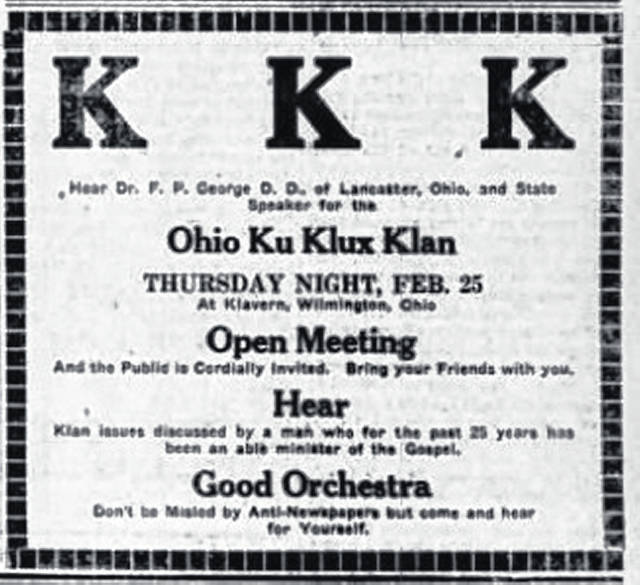

Editor’s Note: This is Part 3 of a series written by Neil Snarr commemorating Black History Month.
In the first Ku Klux Klan article I quoted the News Journal as saying the dedication of the new Klavern building on Ludovic St. (now Quaker Way) would be dedicated on Aug. 1, 1925 and, after a lengthy parade, they were expecting 60,000 Klan visitors to conclude the celebration.
To my surprise, after the description of the parade, the WNJ made no mention of the projected 60,000 visitors. Newspaper articles then focused on the national and state Klan meetings at Buckeye Lake attended by 500 Clinton County members of the Klan.
Local attention in the News Journal to Klan activities diminishes significantly after this, but there are several large ads in the paper, one of them saying “Don’t be Misled by Anti-Newspapers but come and hear for Yourself.”
After these few references to the Klan and its Klavern comes the 1932 announcement that the college has secured the auditorium to be used as a woman’s gymnasium. The Klan essentially disappeared from the local news.
This rapid disappearance of the Wilmington/Clinton County Klan corresponds very closely with the Klan’s nationwide demise. WWI and the very successful motion picture “Birth of a Nation” are universally identified as reasons for the emergence of the Klan.
Its decline is attributed to government investigation related to Klan violence and internal corruption. However, it seems clear that there is always an underlying openness in the U.S. for this kind of movement.
With reference to the manifestation of this most successful era of Klan activity, a student of this 1920s phenomena cautions his fellow historian’s analyses: “A problem with this more objective and dispassionate type of scholarship, however, is that it may fail to provide readers with a full appreciation of how inherently mean-spirited the Klan movement was and thus why it was so ardently opposed.
“Although Klansmen may have attempted to address legitimate problems and many were sincerely striving to create a better community for their families and fellow citizens, they also knew full well that they belonged to an organization that conspired, spied, lied, and deliberately provoked fear among innocent people. That Klansmen were largely rational and well-established citizens makes their decision to affiliate with the Invisible Empire all the more reprehensible.”
Neil Snarr is Professor Emeritus at Wilmington College.



